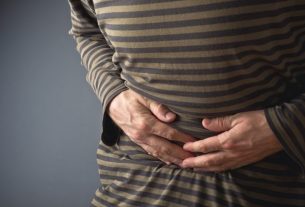Symptoms of appendicitis can vary depending on the location of the appendix and the type and duration of inflammation, but typically include severe abdominal pain on the right side of the belly, fever, loss of appetite, diarrhea, nausea and vomiting.
Generally, the pain of appendicitis begins within the first 24 hours after the onset of inflammation, appearing milder at first, but tending to become more intense after 48 hours.
It is important to go to the emergency room whenever symptoms suggestive of appendicitis appear, so that it can be identified and treated immediately, which is normally done through surgery to remove the appendix. See how surgery for appendicitis is performed.
Check out more about the symptoms of appendicitis with Dr. Antônio Carlos:
9 classic symptoms of appendicitis
The symptoms of appendicitis appear quickly and intensely, the most common of which are:
1. Pain in the lower right side of the belly
The pain from appendicitis is usually sudden and starts in the lower right side of the belly. In some cases it can also start around the navel and, little by little, move to the lower right side, worsening when coughing, sneezing or walking.
2. Loss of appetite
Being a very common symptom of appendicitis, loss of appetite can happen due to excessive pain and nausea caused by inflammation.
3. Nausea and vomiting
These symptoms may arise due to the paralysis of bowel movements.
4. Diarrhea or constipation
Diarrhea or constipation are common especially in people who have the tip of the appendix located in the pelvic region, thus reaching the rectum, which is the final part of the intestine.
5. Difficulty releasing intestinal gas
During appendicitis, the intestine loses its natural movements, making it difficult to eliminate gases.
6. Abdominal bloating
Constipation and gases generated by intestinal obstruction can cause abdominal bloating.
7. Low fever
Low fever, with temperatures between 37.5ºC and 38ºC, usually appears after 1 or 2 days of inflammation as a response from the immune system to try to combat the inflammation.
8. Pain or difficulty urinating
Difficulty urinating occurs mainly in people who have the tip of the appendix located in the pelvic region.
9. Bad being generalized
The discomfort and malaise caused by inflammation can cause generalized discomfort.
Online symptom test
If you think you may have appendicitis, mark your symptoms in the test below:
Chronic appendicitis symptoms
Although acute appendicitis is the most common type, some people may develop chronic appendicitis, where symptoms often include severe generalized abdominal pain in the right side and lower abdomen, which may or may not be accompanied by the symptoms of acute appendicitis, such as fever. and nausea.
This pain can last for several months or years until the correct diagnosis is made. Learn about other conditions that can cause symptoms similar to appendicitis.
Symptoms of Appendicitis in Babies and Children
Appendicitis is a rare problem in babies, however, when it happens, it causes symptoms such as abdominal pain, fever and vomiting. In addition, in some cases, swelling and extreme sensitivity to the touch of the belly can also be observed, which causes the baby to cry.
In children, symptoms progress faster compared to symptoms in adults, and there is a greater risk of perforation, because they are more fragile in the abdomen.
Therefore, if appendicitis is suspected, it is very important to go immediately to the emergency room, or to the pediatrician, so that the necessary tests can be carried out and appropriate treatment can be started quickly.
Symptoms of appendicitis in pregnant women
Symptoms of appendicitis in pregnant women can appear at any time during pregnancy, however, they are more frequent in the first two trimesters of pregnancy.
Generally, the pain of appendicitis during pregnancy can be a little different, due to the displacement of the intestine by the growth of the uterus, and pain may occur on the right side or even in the upper right part of the belly.
Furthermore, at the end of pregnancy, symptoms may be less specific and may therefore be confused with contractions at the end of pregnancy or other abdominal discomfort, which can make diagnosis difficult and delay treatment. See how appendicitis is diagnosed.
When to go to the doctor
It is important to go to the doctor immediately if symptoms of appendicitis appear, especially if after a few hours they also appear:
- Increased abdominal pain;
- Fever above 38ºC;
- Chills and tremors;
- Vomiting;
- Difficulty having a bowel movement or releasing gas.
These symptoms may indicate that the appendix has ruptured and that feces have spread throughout the abdominal region, potentially causing a serious and life-threatening infection.

Sign up for our newsletter and stay up to date with exclusive news
that can transform your routine!
Warning: Undefined array key "title" in /home/storelat/public_html/wp-content/plugins/link-whisper-premium/templates/frontend/related-posts.php on line 12
Warning: Undefined array key "title_tag" in /home/storelat/public_html/wp-content/plugins/link-whisper-premium/templates/frontend/related-posts.php on line 13





